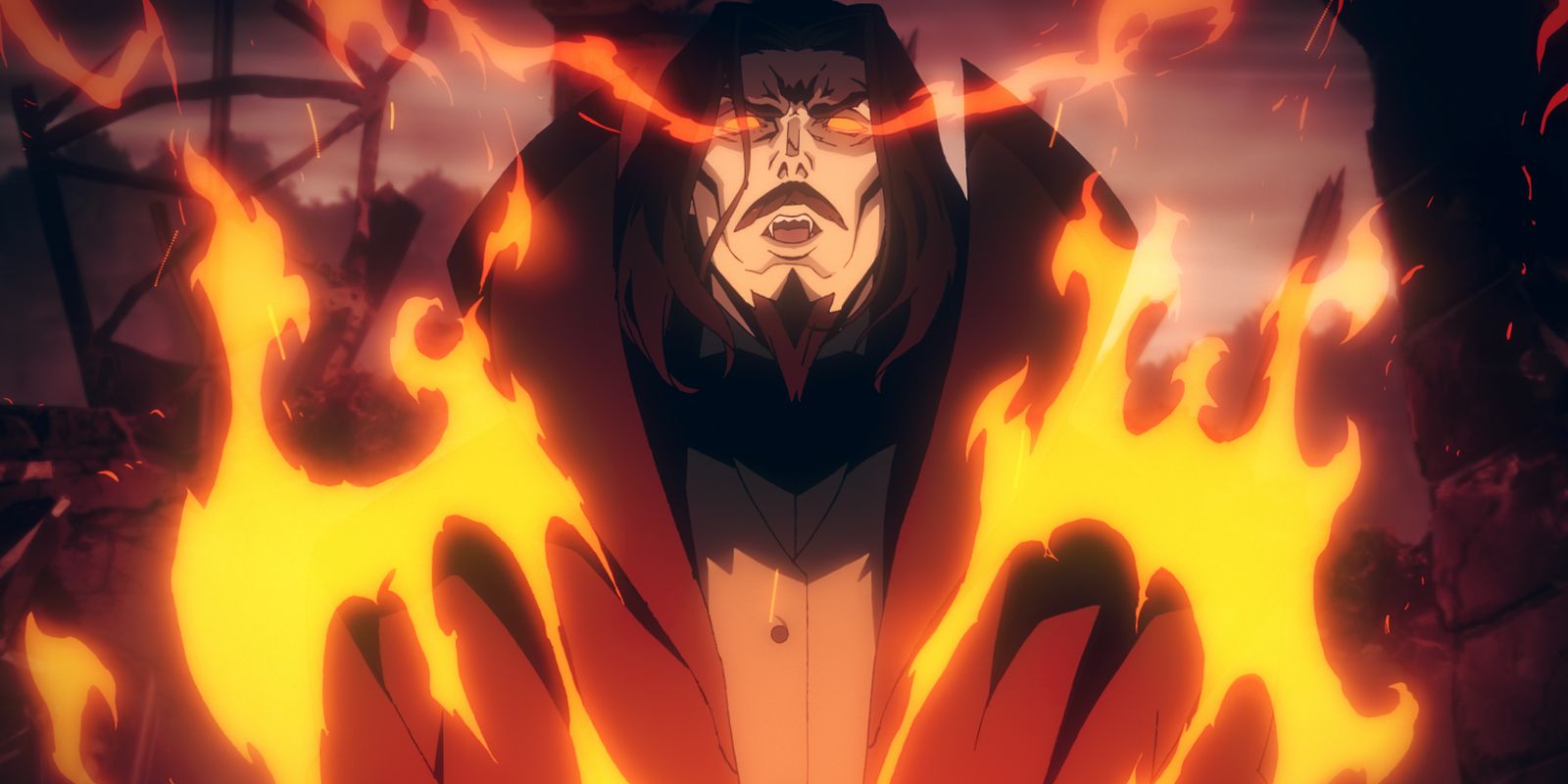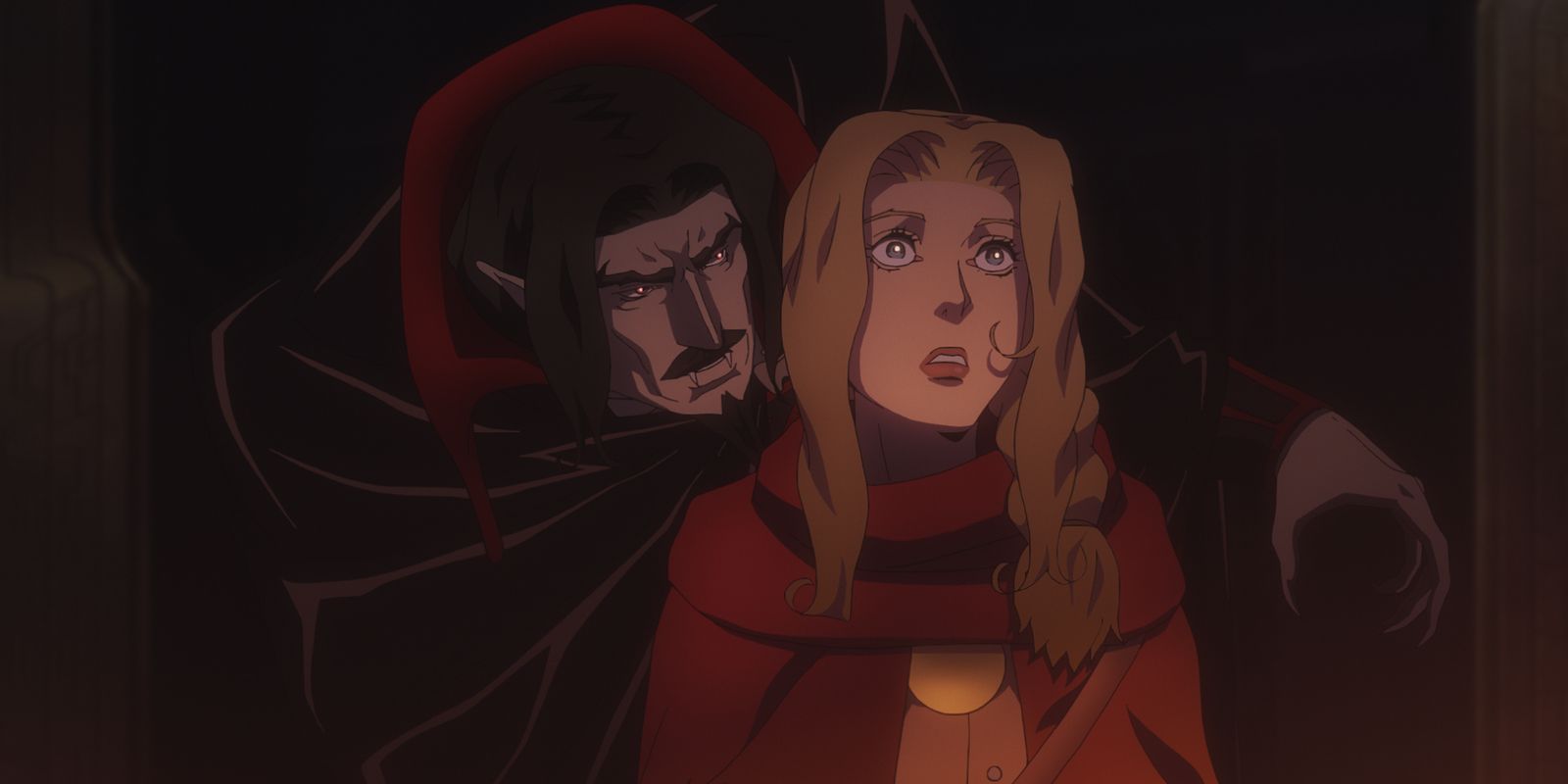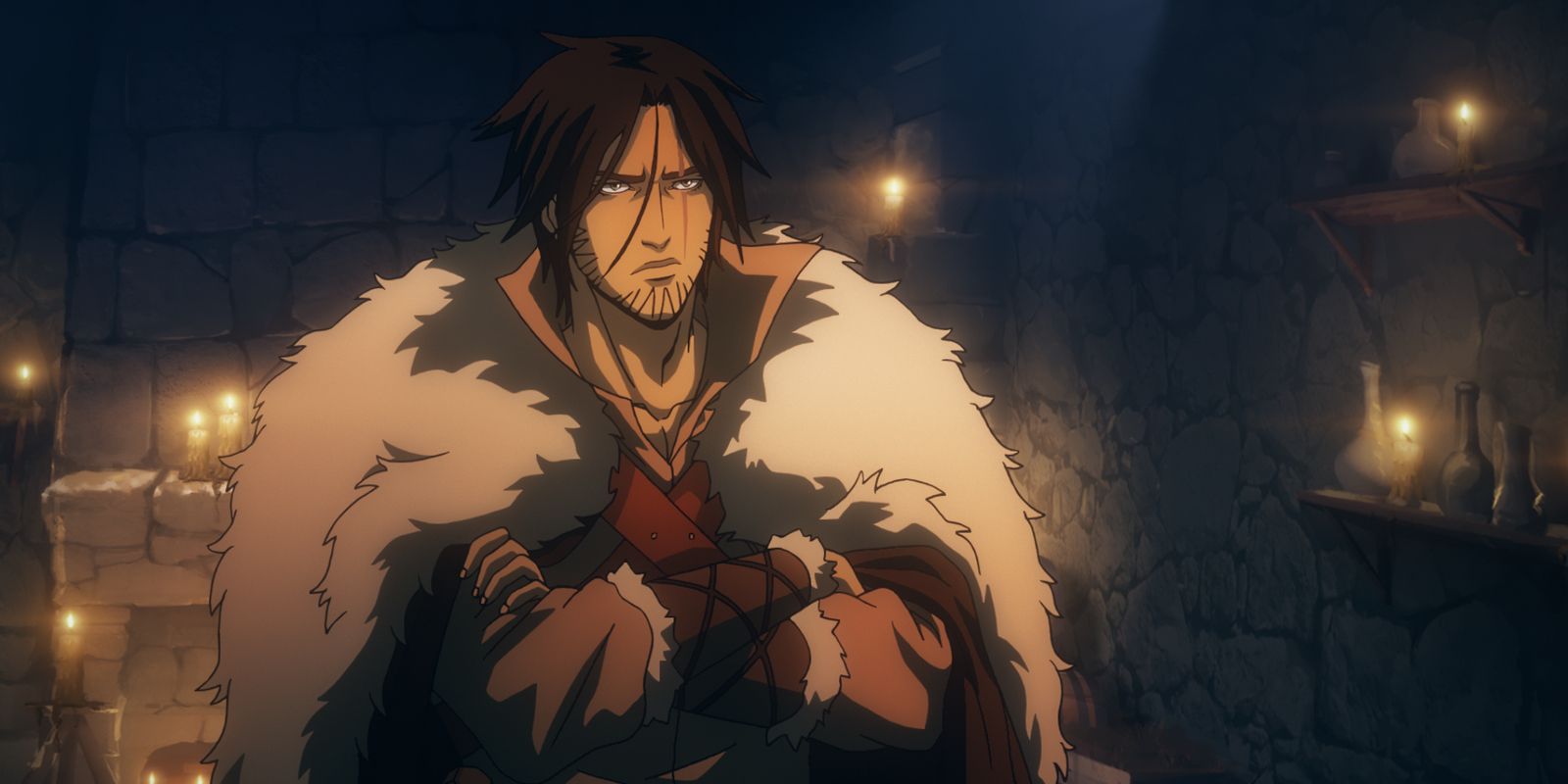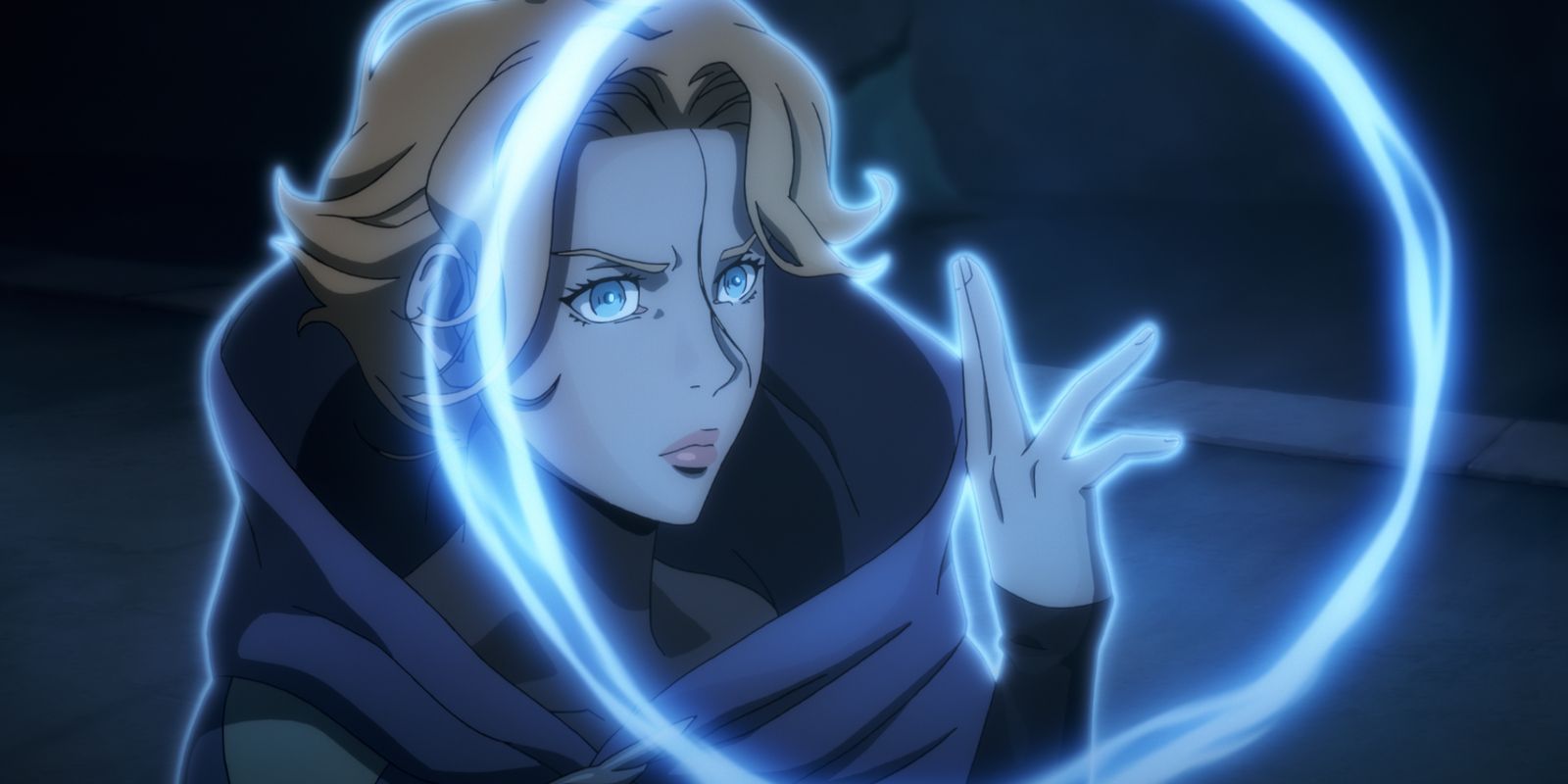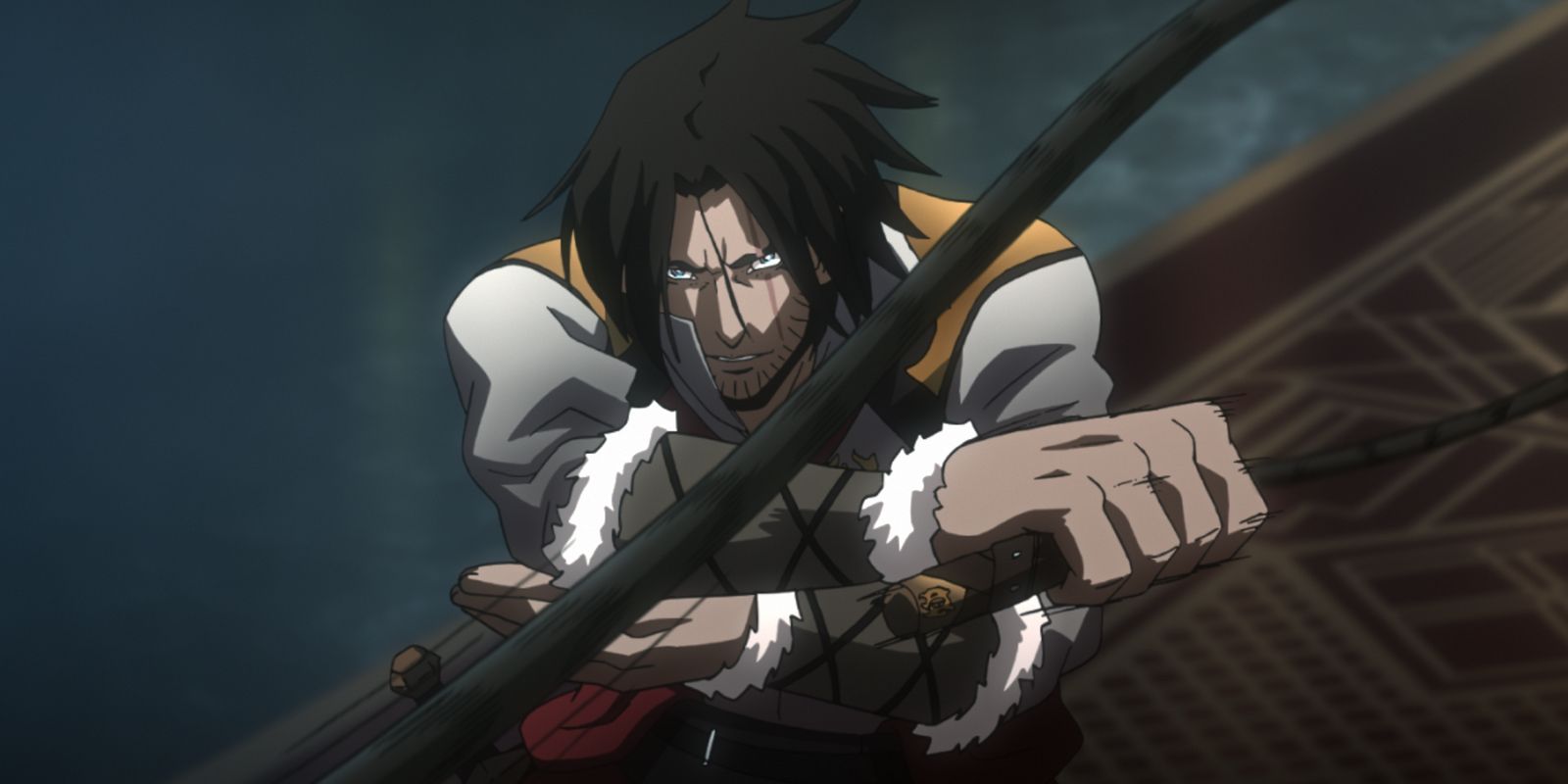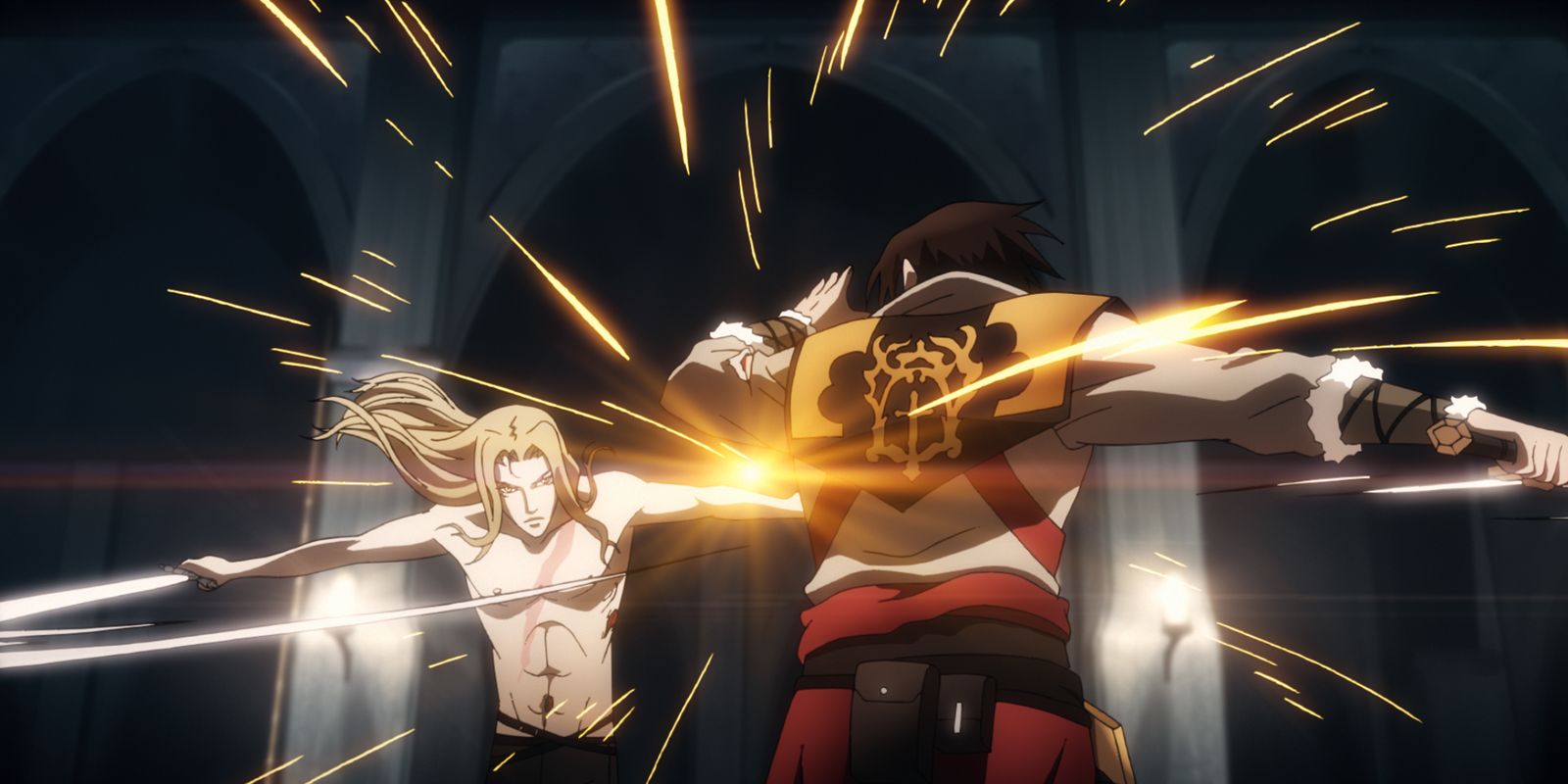The first season of Netflix's Castlevania is a faithful and ultra-violent, though very short, adaptation of the hit gaming franchise.
[WARNING - This review contains SPOILERS for Castlevania season 1.]
-
Premiering today on Netflix, Castlevania is a mini-series based on the classic Konami video game series of the same name. Written by Warren Ellis and directed by Sam Deats, the animated series loosely adapts the plot of Castlevania III: Dracula's Uprising, which is, in fact, a prequel to the original 1986 game. It depicts why Dracula Vlad Tepes summons a demon horde to descend on Wallachia and destroy mankind, as well as the vampire hunter, Trevor Belmont's crusade to stop him.
Talk of an animated adaptation of the popular video game series began in 2015, when producer Adi Shankar (Dredd) shared his hope of adapting Castlevania III into a "hard hitting anime" with a lot of violence and gore. More recently, Shankar compared the series' vibe to that of Game of Thrones, suggesting the series will be handling the lore of Castlevania in a very mature manner.
The animation comes from Powerhouse Animation Studios (whose previous projects include video games Mortal Kombat X and DC Universe Online), with additional animation by Frederator Studios. Stylistically, Castlevania pulls inspiration from the designs and illustrations of Ayami Kojima (an artist who worked on many of the later Castlevania games, beginning with 1997's Symphony of the Night) as well as classic vampire anime like Hellsing and Trinity Blood. All in all, the look of Netflix's Castlevania fits perfectly with pitch for the series, depicting a beautifully gothic world filled with heroes and horrors alike.
Still, given the sorry state of most video game adaptations, the pedigree of those involved could mean very little in the end. So does Netflix's Castlevania do right by the property? And does it fulfill Shankar's promise of bringing a harder, more mature edge to the material? Read on below for our review of all four episodes of the Netflix Castlevania animated mini-series. The first season of Netflix's Castlevania is a faithful and ultra-violent, though very short, adaptation of the hit gaming franchise.
Episode 1 - Witchbottle
For a series centered on a family of vampire hunters, Castlevania begins from the unlikely perspective of Lisa - a young medicine woman who wishes to learn more about her craft even though such science is considered black magic and heresy. She comes alone to Dracula's castle in search of this forbidden knowledge and catches the vampire off guard with her forward-thinking attitude. Though frightened, Lisa remains determined and eventually Dracula agrees to teach her.
Twenty years pass, during which the two are married and Dracula lives with her as a man and not a creature of darkness. Their bliss, however, does not last and while her husband is away, Lisa is abducted by the Church, found guilty of witchcraft and burned at the stake. Learning of what happened, Dracula quickly returns to his old, vengeful ways, wishing to destroy those who took away the only thing which in his eyes redeemed mankind. He comes to the crowd gathered for his wife's execution and speaks to them through the flames, condemning all those present and declaring that in a year's time he will return with an army and destroy everything they hold dear.
Again, it's an interesting starting point for the series, establishing Dracula's desire to destroy humanity as stemming from pain and loss, not just some genocidal glee. This isn't to suggest Dracula isn't a villain, far from it, but the touching backstory does paint him in a slightly sympathetic light. Graham McTavish, who voices Dracula, evokes that sympathy with his performance, emoting a real sense of grief when Dracula learns of his wife's fate. However, that grief quickly turns to anger, which McTavish translates into a menacing performance. Paired with some stunning visual work of Dracula's face within the flames, the whole scene caps off what is an impressive opening act.
Though only in this first episode for obvious reasons, Lisa is an intriguing window into the world of late 15th century Wallachia, illustrating that the Church's hold on people's minds isn't as firm as the later mob would have us believe. Voiced by Emily Swallow, she's headstrong and curious and her ability to see Dracula's better nature hints at that of another character (and definite fan-favorite) who's teased briefly near the end of this episode.
Casting Dracula as a vengeful god and Lisa as the only thing standing between him and the destruction of all mankind, "Witchbottle" includes some fascinating biblical parallels, bringing an even stronger maturity to the material than the extravagant violence - of which there is quite a bit, even in this first episode.
Episode 2 - Necropolis
The Castlevania games span generations of the Belmont family - a great house of Wallachia who for centuries protected the people from vampires, demons, and all kinds of evil monsters. By the time of this animated series, however, a religious fanaticism has enveloped the land and the Belmont family, believed to consort with black magic to battle such creatures, have been excommunicated. Their house and family name in ruins, only the last son of the Belmont family remains - Trevor.
Introduced in the final moments of "Witchbottle", the second episode catches up with Trevor as he engages in a bar brawl with peasants angry at the great families - and the Belmonts, specifically - for bringing Dracula's wrath upon them. That isn't how it happened, of course, as we well know it was the Church who set these events in motion. Easily dispatching with the bar patrons (he is used to fighting "f--king vampires", after all), Trevor travels to the town of Gresit, currently undergoing nightly attacks by Dracula's minions.
It's here that Castlevania begins exploring its video game roots, depicting a bit of platforming as Trevor must navigate a moat to enter the city, followed by a string of interactions with various townspeople that's sure to remind gamers of seeking information via NPCs (non-player characters). It's also during these scenes that Trevor first uses the Belmont family's signature weapon - a consecrated whip intended to dispatch with all sorts of hell beasts. All of these elements are incorporated seamlessly, and while recognizable as gaming mechanics to those familiar with them, never does it feel like these moments are forced in to only please fans.
As a protagonist, Trevor is surprisingly funny in a sardonic sort of way and Richard Armitage brings a sarcastic edge and a roguish quality to the character. He's a drifter who's happy to spend his remaining days as drunk as the local ale will make him. Though his skills imply he was once a great warrior, without purpose or direction he's become merely an aimless wanderer. That is, until he saves an elderly man from some sadistic priests and learns that an order of clerics - referred to as Speakers for their tradition of passing on arcane knowledge through spoken word - are being persecuted by the Church. The Speakers refuse to leave Gresit until they recover the body of one of their own who ventured deep beneath the city in search of an ancient warrior, so Trevor makes them a deal: If he can return the body of the dead Speaker, they will flee the city and seek sanctuary elsewhere.
While the first episode was a surprising start, "Necropolis" picks up where we'd expect a Castlevania story to go - introducing the tale's hero and managing to put him on a path that will see him protecting innocents from great evil.
Episode 3 - Labyrinth
The Speakers are a new element of Castlevania lore, though the series has included magic wielders in the past. In the series' third episode, "Labyrinth" more is revealed about this ancient order as we're introduced to their missing member - Sypha Belnades. Not as dead as her fellow Speakers had thought, Trevor comes upon her encased in stone when he enters the catacombs beneath Gresit.
Sypha came here searching for a fabled soldier said to be sleeping beneath the city, but all she found was a rampaging Cyclops who turned her to stone with his gaze. That same Cyclops is waiting for Trevor when he arrives and the ensuing battle is an excellently animated sequence. In fact, each fight scene thus far has been fantastic, with exciting choreography that's deftly illustrated with fluid, smooth movements. This fight with the Cyclops, however, is especially dynamic and promises Castlevania's animated action will be second to none.
Alejandra Reynoso's performance is quite serious when we first meet Sypha, but as the episode goes on she lightens her tone. She also gets to deliver what is easily the most unexpected joke in the whole series. Sypha and Trevor's relationship begins on rocky terms as his disenchanted manner clashes with her firm beliefs, but as the two work together to escape the labyrinth it's clear they make a good team.
Once back among the other Speakers, it's revealed that the priests from the Church have been manipulating the people of Gresit against them, blaming the Speakers and their forbidden knowledge for why the demons attack the city each night. This builds an interesting critique, making the Church's fanaticism just as cruel as Dracula's army, corrupting people to act against their better nature and hinting at a much larger war for the very soul of humanity. It also firmly places the Speakers and Trevor Belmont as outcasts of respected society, allying them against both the Church and Dracula.
More than any previous episode, "Labyrinth" begins expanding on Castlevania's lore, delving into the history of both the Belmont vampire hunters and the magical scholars within the Speakers' ancient order. Together, they'll need to rally the people of Gresit to fight off the attacking army. But could another ally still be found sleeping beneath their feet?
Episode 4 - Monument
In its season 1 finale, Castlevania lets loose and gives viewers what they've been promised - a lot of violence and gore. Not that the series has really been lacking either up to this point, but as Dracula's army of devils descends on the city the carnage reaches another level.
Having stood with the Speakers against the Church's priests, Trevor reclaims his heritage and his purpose. With the Church's leadership in shambles, it's up to him to lead Gresit's people against the demon horde, quickly taking charge of the battlefield like a seasoned general. The Speakers, however, are by nature a peaceful people so the fighting is left to Trevor and his meager army of peasants, but Sypha cannot stand by and do nothing. She joins the fray and proves herself most useful, dispelling demons with elemental magic. It's another thrilling display made all the more fantastical by Sypha's spells.
Together, they hold the line until the damage gets out of control and the floor of the city square collapses, sending them plummeting into the depths beneath. Now much deeper in the catacombs than before, Trevor and Sypha discover the resting place of that fabled sleeping soldier - a coffin, and inside it, a vampire. Trevor quickly determines this vampire is not the messiah Sypha was hoping for but rather a "floating vampire Jesus" and attacks.
Vampire and vampire hunter engage in a spectacular duel, and when it ends, there's no clear winner as both would likely have killed the other were it allowed to continue. Impressed with Trevor's skill, the vampire finally introduces himself as Adrian Tepes, better known as Alucard, son of Dracula and his human wife, Lisa. Alucard is eloquently portrayed by James Callis with an air of sophistication that masks his fierce, vampiric nature, and it'll be interesting to see how he upends the strong bond already forming between Trevor and Sypha.
"Monument" is an action-packed finale, wrapping up Trevor's arc of reclaiming his family's honor and purpose while leaving much of the story yet to be explored. Fans of the property will undoubtedly have a good idea where the series goes next, but even without any foreknowledge it's an exciting prospect having these three characters - a vampire hunter, a mage, and Dracula's half-breed son - finally together and ready to set out on the next adventure.
Conclusion
Already, Netflix has ordered a second season of Castlevania and that's good news because season 1 only scratches the surface of what this property can offer. Filled with spectacle, fascinating characters, and a healthy dose of the macabre, Castlevania proves a rousing tale for adaptation. Though clearly inspired heavily by the games, these four episodes play more like a full length movie than a collection of cut scenes (and it's possible the original intention was for a film over a series anway).
Beautifully animated, the style of Castlevania is sure to inspire more adult-oriented action series (like Shankar's other planned animated adaptation of Assassin's Creed), but it also sets a high bar for the genre. Video game adaptations have never been done as good as this one, managing to faithfully represent the spirit of the property while also injecting new material. Were you not already a fan of Castlevania, this series is sure to have you checking out one of the many games in the franchise, while for longtime fans, this adaptation could be just what's needed to rekindle interest in the property.
The entire first season of Castlevania is now available on Netflix.

